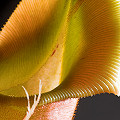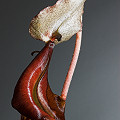Q: Nepenthes: basic cultivation
A:
Nepenthes species are huge, spectacular, and often very, very expensive. As such, growers put great
effort into growing them, and emotions on how this should be done
can ride high. I think this explains why
people who have developed different horticultural prescriptions are sometimes very vocal and even combative in
defending their methods.
Many of these methods are in direct conflict with each other. Which method should you use? Whatever works! You see, with this genus it is
particularly true that what works well for one person does not work well for another. For example, if one person grows their
plants in a greenhouse that is slightly less illuminated but much more humid with frequent waterings, the planting mix used does not need to
retain much water--the plants might do very well
with a planting mix that is almost pure aggregate and is very well drained. Meanwhile, if another grower has a very brightly lit greenhouse
that is a little more dry and the waterings are rarer, the planting mix should have more Sphagnum
to retain water. Whenever I get a new plant from
another grower I repot the plant as soon as possible into a mix that I have found works well for me.
On this page, I will provide only the basics of Nepenthes
cultivation methods that work well for me. This is a standard method, and has given me reasonable
success over the last 20+ years. Adopt them, and you will have a reasonable chance of growing these plants. However, instead of just relying upon my suggestions I strongly
encourage you to buy a more comprehensive set of instructions such as from a good book, or surf the web to more dedicated Nepenthes
web sites.
Setting: Most Nepenthes are large plants (or will become large plants in time), and need plenty of room.
Terraria simply do not make sense. Windowsills and outdoor settings are not suitable because the humidity is too low. However, if
you live in tropical environments, you should try growing some plants outside. You may live in a place where they can be kept
outside!
If you want to restrain your plants to a terrarium, consider the ever-diminutive species such as
N. gracilis or N. bellii.
Nepenthes glabrata is a good subject for a highland terrarium because it is small.
Light: Bright, diffuse sunlight is excellent. Artificial lighting may be adequate if it is bright enough.
Humidity and water: The relative humidity should be very high, at least about 60% and probably closer to 90% would be best. With
inadequate humidity, your plant's leaves will tend to burn on the edges, and the tendrils will not successfully develop pitchers.
You should water your plants from above, as plants sitting in trays often have dwarfed root systems. Those who live in the tropics
often can violate this rule, but such growers are already in such good conditions I am not surprised they can cut corners
here and there. Water should be purified to be safe, although many tell me this is not so important.
Pot type: I prefer plastic, although this is apparently not a critical issue. Do not repot your plants unless you really have
good reason. Repotting often sets the plants back a bit, even though it might make you feel better.
Soil: People argue about this endlessly. The soil you should use, I think, is a reflection of your other conditions. Here is my
advice. Start with a 50:50 long fiber Sphagnum: perlite mix. That is a good, general prescription.
But on some of your plants, try something a little different. After about a year, knock the plants out of the pots and look
carefully at the root systems. If the root system is exploring the medium, great. If it is not, and is just sitting there
looking ill, you should try a different soil mix. Do not trust anyone's prescription blindly---whatever method you use, test it
from time to time and see if it is working. Can you improve upon your method?
Temperatures: As you have seen on my FAQ pages,
Nepenthes are broadly divided into two groups, highland and lowland species.
Temperatures for the steamy lowland species should be about 30-34°C (86-93°F) during the day and about
8°C (14°F) colder at night. Highland species prefer temperatures in the range of 25-30°C (77-86°F),
and nighttime temperatures about 10°C (18°F) colder.
Fertilizers: If you really want to fertilize your plants, you can try an orchid or epiphytic fertilizer poured directly into the
pitchers once to twice a month. Start with small amounts and observe the effect.
But if you want to travel far down this path refer to more detailed descriptions given in
Clarke (2001) or D'Amato (1998a, 2013). I do not use fertilizer on my Nepenthes, although I am not denying they
might benefit from it.
Page citations: Clarke, C. 2001; D'Amato, P. 1998a, 2013; Rice, B. 2006a; personal observations.

